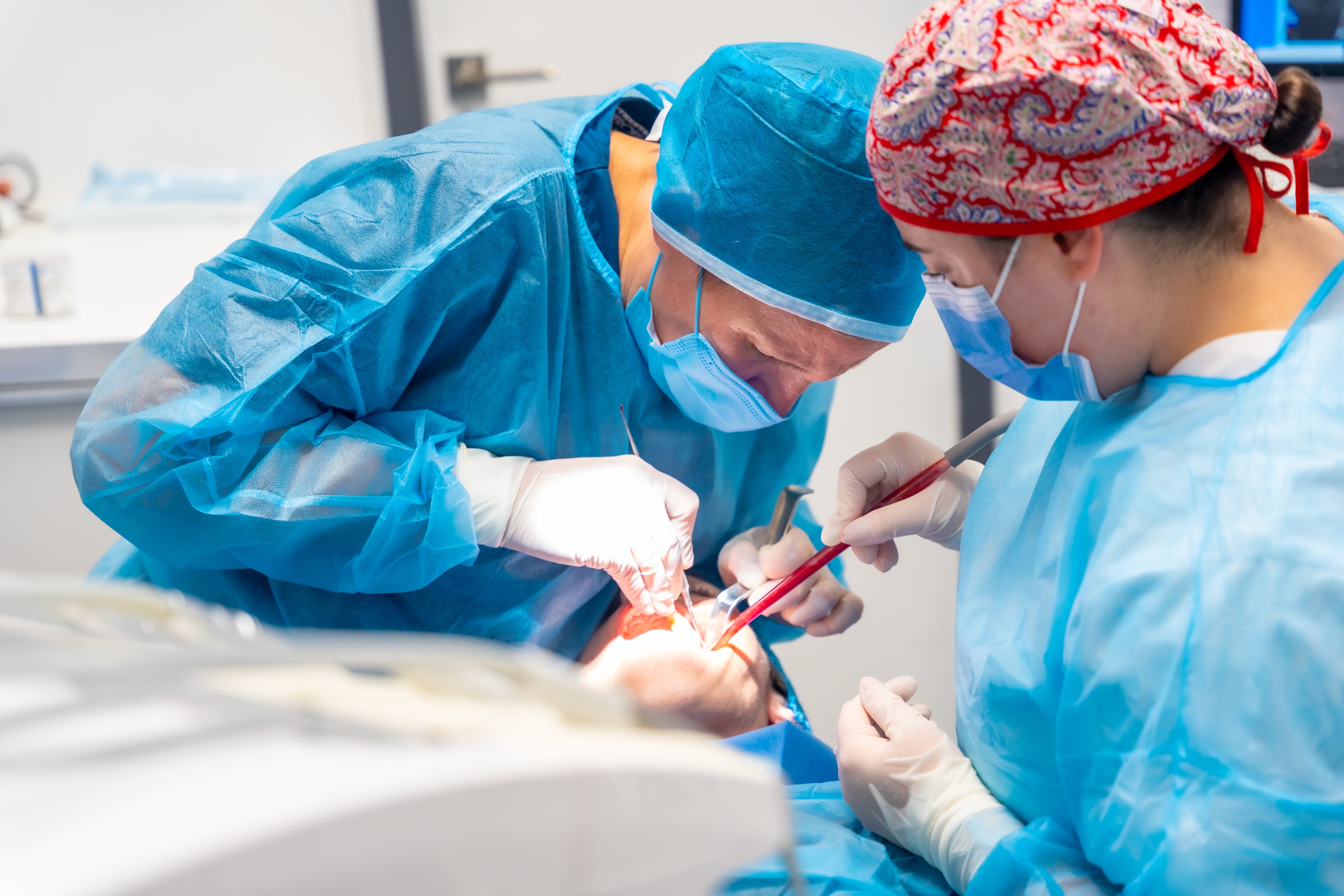
Are you struggling with a misaligned jaw, trouble chewing, or even sleep apnea? If so, you may have heard of double orthognathic surgery. This life-changing procedure, also known as corrective jaw surgery, addresses these challenges by correcting jaw misalignment and enhancing not only your dental health but also your overall quality of life.
At South Calgary Oral Surgery, our specialized team of oral and maxillofacial surgeons are here to guide you through this transformative journey. Here we’ll explore how double orthognathic surgery can offer solutions for misaligned jaws, jaw joint pain, and other related conditions. We’ll also discuss what to expect from the procedure, including the benefits for your health, function, and appearance.
What is Double Orthognathic Surgery?
Double orthognathic surgery, also known as double jaw surgery, is a sophisticated surgical procedure designed to correct misalignments or irregularities in both the upper and lower jaws. This type of jaw surgery is typically performed by highly skilled oral and maxillofacial surgeons to address functional issues caused by skeletal discrepancies in the jawbones.
The primary goal of double orthognathic surgery is to improve the alignment and function of the upper and lower jaws, as well as the upper and lower teeth, to achieve optimal facial balance and functionality. By repositioning the jawbones, this surgery not only enhances the structural harmony of the face but also alleviates issues such as difficulty chewing, speaking, and even breathing.
The Jawbone Foundation: Why Double Orthognathic Surgery is Essential for Health and Balance

Think of your jaw as the foundation of a house. If the foundation is off, everything from the doors to the windows to the roof will be affected. Similarly, when your upper and lower jaws are misaligned, it can trigger a cascade of problems.
Just as a shaky house foundation leads to crooked walls and sagging floors, misaligned jaws can lead to a domino effect of complications—everything from jaw joint pain to chronic headaches, temporomandibular joint disorders (TMJ disorders), and improper bites that impact daily activities like chewing and speaking.
When the jaw bones don’t sit in harmony, it puts undue strain on your jaw muscles and teeth, potentially causing excessive wear on your lower teeth and upper teeth and even contributing to tooth decay. Over time, this can result in more serious conditions, such as gum disease or facial structure imbalances, that may worsen with age.
The only way to fully correct these issues is to restore proper alignment between the upper jaw (maxilla) and the lower jaw (mandible) through double orthognathic surgery.
Unlike traditional orthodontic methods, double orthognathic surgery addresses both the cosmetic and functional aspects of severe jaw misalignment. This comprehensive approach corrects the “foundation” of your facial structure, creating balance, improving function, and preventing future dental health problems. It’s especially effective for cases where orthodontic treatment alone, such as braces, cannot resolve the misalignment.
Fixing Both Upper and Lower Jaws: How Double Orthognathic Surgery Works

Unlike single-jaw surgeries, which only address either the upper jaw or lower jaw, double orthognathic surgery (also referred to as bi-maxillary osteotomy) tackles both. This dual realignment provides a far more comprehensive solution for patients dealing with severe jaw misalignment, facial asymmetry, or complex bite issues like open bite or improper bite.
When both the upper and lower jaws are out of alignment, everyday activities like chewing, speaking, or even breathing can become difficult, affecting your overall quality of life.
The surgical procedure begins with precise incisions to reposition the jaw bones. Titanium screws are then used to secure the jaws in their new, corrected position, promoting proper healing and stability. This realignment not only improves functionality, such as reducing difficulty chewing or minimizing jaw pain, but also dramatically enhances your facial aesthetics by bringing balance to your facial features.
Beyond just fixing functional problems, double orthognathic surgery plays a key role in boosting facial symmetry, helping patients feel more confident about their appearance. Whether you have a receding chin, a protruding jaw, or an uneven facial structure, the surgery reshapes both the upper and lower jaws, giving you a more harmonious look while also improving the overall function of your jaw muscles and teeth.
Sleep Apnea No More: Double Jaw Surgery for Better Breathing and Sleep

Did you know that double orthognathic surgery can also help treat severe obstructive sleep apnea? When the upper and lower jaws are misaligned, it can constrict the airway, making it difficult to breathe while sleeping. By moving the jaws into a more ideal position, the airway is opened up, which reduces or even eliminates obstructive sleep apnea symptoms.
Research has shown that jaw surgeries like maxillary osteotomy and mandibular osteotomy are highly effective for patients suffering from sleep apnea. Once the upper and lower jaws are repositioned, patients often report improved sleep quality, reduced snoring, and better overall health.
Enhanced Aesthetics and Functionality: The Cosmetic Benefits of Double Orthognathic Surgery

While the primary goal of double jaw surgery addresses functional problems, such as jaw misalignment or difficulty chewing, the cosmetic benefits are often equally significant. Many patients with misaligned jaws struggle with a receding chin, uneven facial structure, or even visible facial scars from previous injuries or conditions.
These physical traits can impact self-esteem, making patients feel self-conscious about their appearance. However, by adjusting both the upper jaw and lower jaw, double jaw surgery not only resolves functional issues but also enhances facial symmetry and improves facial aesthetics.
For many, this surgery leads to a dramatic transformation in their appearance, bringing a sense of balance to their facial features. Patients report feeling more confident after the procedure, as the alignment of the upper and lower jaws not only relieves jaw pain and other physical issues but also improves the overall harmony of the face.
Whether you have a protruding jaw, a receding chin, or an asymmetry that affects your smile, double orthognathic surgery offers a comprehensive solution that enhances both form and function.
Additionally, the procedure can minimize the appearance of facial scars and other imperfections by restructuring the facial bones. This dual focus on function and aesthetics ensures that patients can enjoy better health, improved dental health, and a more pleasing appearance all at once.
The Role of Orthodontics in Double Orthognathic Surgery: A Winning Combination

For many patients undergoing double orthognathic surgery, the procedure itself is only part of the journey toward achieving a healthy, well-aligned bite. Orthodontic treatment often plays a critical role either before or after surgery, helping to ensure that your upper teeth and lower teeth fit together perfectly once your jaws have been repositioned.
Without this fine-tuning, even a successful jaw realignment can leave you with residual improper bites or open bites, potentially compromising the long-term success of the surgery.
Braces or clear aligners are commonly used to gradually move the teeth into the correct position, working in harmony with the surgical adjustments made to the upper and lower jaws. By coordinating orthodontics with surgery, patients can achieve a stable and long-lasting result, where the bite functions as it should and the teeth wear evenly over time.
This reduces the risk of complications like excessive wear, tooth decay, or even gum disease—issues that can develop if teeth remain misaligned despite corrective jaw surgery.
The combination of orthodontic treatment and surgery addresses both structural and dental aspects of jaw misalignment, ensuring a holistic approach that improves not just the position of your jaw bones but the overall health and function of your teeth as well.
Long-Term Results and What to Expect Post-Surgery

Recovery from double orthognathic surgery is a process that requires both patience and dedication, but the outcome is transformative. Immediately following the procedure, patients typically need to adhere to a soft food diet, as chewing is restricted to promote healing.
Physical activity should be avoided for several weeks, and it’s common to experience some swelling around the jaw and face.
Despite these temporary challenges, the results are worth the effort: as the jaw bones heal and settle into their new positions, patients often experience significant improvements in jaw function, as well as enhanced facial appearance and facial symmetry.
The key to this success lies in a combination of careful planning, state-of-the-art surgical techniques, and a thorough post-surgery recovery plan. With proper aftercare, patients can look forward to a favourable outcome that not only improves their daily comfort and health but also boosts confidence in their appearance.
Who Needs Double Orthognathic Surgery?

Double orthognathic surgery is typically recommended for individuals who have severe misalignments or irregularities in both the upper and lower jaws. This can include conditions such as:
Severe Overbites or Underbites: When the upper jaw significantly overlaps the lower jaw or vice versa.
Crossbites or Open Bites: Misalignments where the upper and lower teeth do not meet properly.
Facial Asymmetry or Imbalance: Uneven facial structure that affects appearance and function.
Difficulty Chewing or Speaking: Problems caused by misaligned jaws that impact daily activities.
Obstructive Sleep Apnea (OSA): A condition where a narrow airway due to jaw misalignment causes breathing difficulties during sleep.
Jaw Joint Pain or Temporomandibular Joint (TMJ) Disorders: Chronic pain or dysfunction in the jaw joint.
The Double Orthognathic Surgery Procedure
Pre-Surgery Journey
Before undergoing double orthognathic surgery, patients typically go through a comprehensive evaluation process. This includes:
X-rays and 3D Imaging: To assess the jawbones and facial structure in detail.
Dental Impressions and Models: To evaluate the alignment of the teeth and plan the surgical approach.
Consultations: With an oral and maxillofacial surgeon and an orthodontist to develop a personalized treatment plan.
Patients may also be required to undergo orthodontic treatment before surgery to align the teeth and prepare the jaws for the procedure. This preparatory phase ensures that the jaws and teeth are in the best possible position for the surgical realignment.
Surgical Procedure
The double orthognathic surgery procedure typically involves the following steps:
General Anesthesia: Administered to ensure the patient’s comfort throughout the procedure.
Incisions: Made in the upper and lower jaws to access the jawbones.
Repositioning: The oral and maxillofacial surgeon repositions the upper and lower jaws to achieve optimal alignment and function.
Securing the Jaws: Using titanium plates and screws to hold the jaws in their new position.
Closing Incisions: The surgical sites are closed, and the patient is taken to the recovery room for post-operative care.
The procedure usually takes several hours to complete, and patients may require a hospital stay of one to two days. After surgery, patients will need to follow a strict diet and avoid strenuous activities to ensure proper healing. The recovery process is crucial for achieving the best possible outcome, both functionally and aesthetically.
Conclusion: Take the Next Step Towards a Healthier, Happier You

Double orthognathic surgery isn’t just about improving your bite or fixing jaw alignment issues—it’s about transforming your life. From addressing jaw joint pain to alleviating sleep apnea and boosting facial symmetry, this surgical procedure offers profound, lasting changes.
At South Calgary Oral Surgery, our team of expert oral and maxillofacial surgeons is dedicated to providing you with personalized care and helping you achieve both functional and aesthetic improvements.
If you’re ready to explore how double orthognathic surgery can benefit you, schedule a consultation with us today. Your journey to better health and greater confidence starts here.






